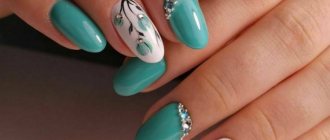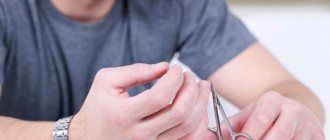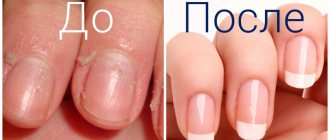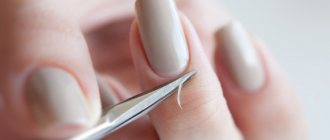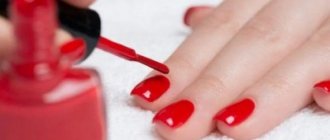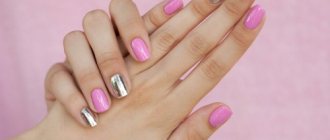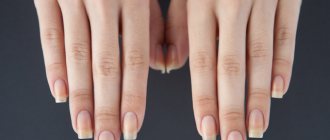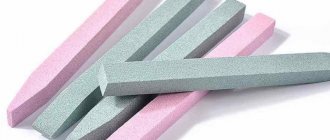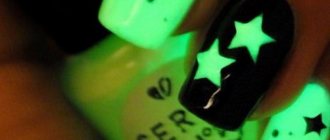What is cuticle
The cuticle is a protective leathery cushion that frames the base of the nail - the matrix. It serves as an obstacle to the penetration of bacteria and foreign bodies into the growth zone.
It consists of eponychium - the upper part, and pterygium - the lower layer, which grows to the nail plate and grows with it. How fast does the cuticle grow? A partial update lasts 14 days, and a full update lasts 21 days. It is within these time frames that it is recommended to perform hardware and trim manicures.
Nail structure and growth: what healthy nails and skin should look like, care rules
Why do you need to take care of your cuticle? Its edge is constantly growing and shedding dead dry cells. Over time, it peels off, cracks, tears, and causes burrs to appear. If an infection is added to this, reddish areas of inflammation appear.
To avoid this problem, it is necessary to take care of the cuticle and nails in a timely manner, take care of nourishing and moisturizing the skin, and remove keratinized dry edges. Let's take a closer look at the basic rules, procedures and cuticle care products. Everything must go together and be carried out systematically.
How to remove dry cuticle?
Dry cuticles are often very problematic. Due to excessive dryness, this part of the nail can no longer provide one hundred percent protection to the entire nail plate. Promotes the appearance of burrs.
The master needs to take care of the dry cuticle; it is worth refusing to trim the manicure so as not to damage the thinnest skin. The capillaries in the dry cuticle are located close to each other, so blood will flow quickly. You can get an infection.
The right solution would be a hardware manicure. The main thing is to choose the right cutter, then the keratinized skin can be carefully sanded rather than cut off. After processing, the skin is treated with special jojoba or almond oil. A moisturizer will do. The main rule is to try not to come into contact with chemicals and hard water, especially without gloves. Otherwise, this may again lead to dry skin.
Care rules, materials and tools
A set of procedures aimed at caring for and maintaining the skin of the hands, cuticles and nails in a healthy and attractive state consists of the following stages:
- Cleansing;
- Hydration;
- Nutrition;
- Masks and wraps;
- Massage;
- Baths;
- Prevention of burrs;
- Measures to slow growth;
- Manicure: hardware, edged and European.
For care you will also need cosmetics, materials and tools, depending on the procedure being performed:
- Moisturizing and nourishing cream;
- Ready-made or homemade massage scrub;
- Paraffin for hot or cold treatments;
- Cuticle oil;
- Grooming pencils as an express method;
- Ready-made masks or ingredients for making at home;
- Ingredients for baths - soap, salt, iodine, aromatic oils, tinctures;
- Medicinal preparations for eliminating inflamed hangnails at home - ointment with silver, Solcoseryl gel, Spasatel balm, Sudocrem;
- Cuticle files - diamond, laser, ceramic;
- Orange sticks or pusher;
- Scissors or wire cutters.
Which manicure to choose
Masters recommend a combined manicure in this situation, that is, a combination of hardware and classic edged. Having put your neglected nails in order in 2-4 procedures, the master will then advise you on a European manicure for systemic care.
Paraffin therapy for cuticles
Additional effective procedures for very dry cuticles and nearby vessels are paraffin therapy and hot manicure. They reduce the risk of injury, increase skin tone in the problem area, nourish it with moisture and seal it for a long time. This reduces the risk of cracking, burrs and skin injuries.
Lyudmila Sheveleva
Doctor, pharmacist
Ask a Question
Experienced professionals often practice applying remover to dry cuticles when there are closely spaced vessels. The product will delicately dissolve dead areas of thin skin. This way you can do without tweezers, which can injure a blood vessel. The remover does not damage healthy epithelium, as it is applied superficially to the cuticle. Then the master cuts off all excess, and only now briefly soaks his hands. The remaining defects immediately become clearly visible, which he carefully removes.
Paraffin therapy for hands - what is it, benefits and step-by-step instructions
Hot manicure - how to do it, what products are needed
Cleansing
Before performing any procedures for caring for the skin of your hands, nails and cuticles, it is necessary to ensure their cleansing. Choose at your discretion:
- Wash your hands with soap or cleansing foam;
- Use a gel marked “soap-free”;
- Apply a gentle gel sanitizer;
- Treat with a disinfectant or antiseptic in the form of a gel or spray;
Soap and other cleansing cosmetics are best used with an optimal pH of 5.5. If water is used for cleansing, it should be warm to eliminate the stressful effects of temperature on the vessels and capillaries of the skin.
Antiseptics and disinfectants are used in the salon format, as they are more aggressive in their effects. Sanitizers are convenient for travel, for the office, and in other force majeure situations where there is no water to clean your hands and cuticles before applying skincare cosmetics or cream.
Brands of good cleansing products: antiseptics Teflex A, Desiptol, Bal Professional, Beautix, Dona Jerdona, RiO Profi, antiseptic oil for cuticles Patrisa Nail. The latter is suitable not only for cleansing and nutrition, but also for treating hangnails.
What should an experienced master do?
Each procedure involves a preliminary examination of the client’s nail plate. The master should also ask you on which nails the cuticle skin grows in, is more sensitive to mechanical stress, and how long ago the previous manicure was done. Such a simple preliminary diagnosis will help prevent pain, discomfort and cuts during the further procedure.
When the first pain appears, tell your master about it; you don’t need to heroically endure the pain, you won’t be given a medal anyway, and your mood will be ruined. However, the master will understand everything herself when tiny droplets of blood appear from the damaged capillary.
- A simple inspection and survey is the first stage.
- The second is the neat, almost jewelry-like work of a master on problem areas and a correctly chosen manicure. Good masters do manicures without cuts, even when blood vessels are close together, while inexperienced ones justify their inability to solve a difficult problem at work. An experienced master will cut off no more than 2/3 of the free edge of the cuticle, leaving a thin section to protect the growth zone of the nail and to prevent the “living” edge from drying out too quickly.
- The third stage is aftercare. By systematically caring for the cuticle skin and preventing its rapid growth, you extend the duration of the manicure by almost two times, and also make it easier for the master to work on difficult areas during the next procedure. And this saves time and gives your hands a beautiful, well-groomed appearance.
Hydration and nutrition
Part of the cuticle grows back already dry, as these are dead skin cells. Additionally, due to insufficient hydration, constant contact with detergents, dust, weather conditions, the skin of the hands dries out, and the cuticle can crack, tear and become inflamed when pathogenic microorganisms enter.
To avoid this, you need to take care of your nails and cuticles, constant hydration and nutrition, both with improvised and special cosmetics.
To do this, after each hand washing and contact with an aggressive environment, it is necessary to apply a moisturizing or nourishing cream. The choice of product depends on the season and the initial condition of the skin.
- You can use a moisturizer during the day, as it has a lighter texture, and at night be sure to apply a nourishing one, or make a mask under plastic. It is better to choose products that are recommended for caring for the skin of your hands and nails at the same time.
- The second option is cuticle oil. The oils, vitamins, minerals and active additives it contains provide multidirectional effects that combine hydration and nutrition at the same time. It is recommended to apply the oil 1-3 times a day after cleansing. 1 drop of the product is placed at the base of the nail, and then distributed with your finger along the entire perimeter of the cuticle.
Types of professional manicure, how a novice master can learn how to do it:
Trim manicure manicure technology:
During a trim manicure, the cuticle and growing skin on the rollers are removed with tools and cut off. This type of manicure is considered harmful and unhygienic due to the fact that it is performed with one tool, but as you understand, this depends only on the conscience of the master and his disinfecting methods.
Disinfection is the basis of your work - a guarantee of health for the client and you!
To make a trim manicure you will use the following tools and materials:
Tools:
- Nail and cuticle nippers;
- Cuticle scissors;
- Pusher or orange stick;
- File for natural nails;
- Nail buff;
- Dust sweeper.
Material:
- Disinfectors;
- Remover;
- Disposable wipes;
- Gloves;
- Mask;
- Bath;
- Filler;
- Cuticle oil;
- Hand cream.
Learning how to do a trim manicure:
- In the first lesson, you learned that all services begin with disinfection of hands (yours and the client’s), as well as tools in front of the client. Put on gloves after disinfection and don’t forget about the mask, but you may find it inconvenient, but believe me, this is important, protect yourself from allergies.
- Finish the free edge with a nail file and give it the shape the client wants. You need to use a file strictly before you soak your nails or after, but your nails should already be completely dry and hard. If you need to remove the length or trim the sides of your nails, first use nail clippers. It is important to remember that you can use nail clippers to trim your nails when they are steamed and become softer. It is not advisable to bite your nails dry, as this will lead to peeling. Remove the film of the nail that will remain on the end after filing with a buff, just grind the nail from top to bottom. Remove dust from the nails with a sweeping brush.
- Take a pusher or a stick, lightly push back the cuticle and apply remover (when doing a trim manicure, using remover is not essential, but it saves a lot of time and will remove most of the soft materials, so we recommend that you don’t skimp in this case, use it).
- Dip the client's hands, or rather fingers, into the warm bath. This type of cuticle soaks for 5-7 minutes (with softening gel).
- Remove your finger from the bath and wipe it, but not dry, it should remain moist. Push back the cuticle all the way, but don't overdo it. There is no need to press down on the pusher, as this can damage the nail and disrupt its growth. Try to guide the pusher almost parallel to the nail. Check if you removed the film well with a buff.
- Take the scissors and carefully, using only one smooth cut, continuously remove the cuticle. You should not throw the cuticle sheet, cut it step by step like a tailor, without interruption, otherwise you will get burrs.
- Using pliers, remove the skin from the side rolls. Do not let the cuticle stick to the blades; to remove it during operation, simply lower them into the bath for a couple of seconds.
- Apply oil to the cuticles and cream to the skin of the hands. After this, you can proceed to the coating. If the systems are gel, then the oil and cream are applied after coating. Why do you need to smear your cuticles with oil? — oil helps the cuticle tighten faster and take on a beautiful, well-groomed appearance; some types have a disinfectant or affect nail growth.
- Organize your work area and tools.
The period between trimming manicures is individual, it all depends on the client’s body, the average is from one to two weeks.
Combined manicure technology:
The name of this type of manicure speaks for itself - it is a combination of 2 typologies (European + edged). In order to learn how to make it you need to have the following tool and material:
Material:
- Disinfectors (for tools and hands);
- Cuticle remover;
- Cuticle oil;
- Hand cream;
- Bath filler (sea salt, cream, etc.).
Tools:
- Pumice pencil for cuticles;
- Wire cutters;
- Cuticle scissors;
- Pusher or orange sticks;
- File for natural nails;
- Buff for natural nails;
- Dust sweeper;
- Disposable wipes;
- Mask for the face;
- Gloves;
- Bath.
Learning how to do a combined manicure:
- Your first step ALWAYS and with every service should be disinfection! Treat the client's hands and then yourself, put on gloves and a mask. Treat the instrument with a spray in front of the client (and after it in the same way, but using the device).
- Take a natural nail file and shape the nails (the free edge of the nail) into the shape the client requests. Sweep away any remaining dust. Don't forget to sweep away the dust with a brush.
- Take a tool to push back the cuticle (a pusher or an orange stick, whichever is more convenient for you). Start with the client’s right hand, it doesn’t matter why. Lightly, carefully push back the cuticle and apply the remover. Leave it on for a few seconds.
- Immerse the client's hands in the bath of filler for 4 minutes. Remember, with a remover the cuticle gets wet faster, so you should not, under any circumstances, keep the visitor’s fingers in the water.
- Remove the client's first finger from the bath and lightly blot it with a napkin. Take an orange stick and push back the cuticle completely, using it to remove the film that was under the cuticle from the nail. After filing, a film may remain on the nails; remove it with an orange stick (just swipe along the free edge from one side to the other).
- Take your cuticle scissors and remove the cuticle from start to finish, you should do this in one cut.
- Take a pumice cuticle pencil and dip it in the bath. The pumice pencil should only touch the skin, not the nail. Be careful near the nail sinuses, a pumice pencil can seriously damage the nail plate. Remember - the pumice pencil should always be wet! Carefully treat the cuticle with it, from its center, first in one direction, then in the other. For a combined manicure, a pumice pencil serves as a polisher for the cuticle, removing its remnants and straightening the cut after scissors.
- Take the nippers and remove excess skin from the side sinuses and rollers (if necessary). Sand the cuts with a pumice pencil.
- Polish your nails, take a buffer and work it from top to bottom. Sweep away any remaining dust. It’s important to remember that you can use a buff on the nail plate only according to its growth from top to bottom!
- Apply cuticle oil to your cuticles and rub it in lightly. Apply the cream to the skin of your hands and distribute it with massage movements. If you plan to apply a coating, then you can apply the cream under regular polish before coating, but you must first degrease your nails before applying it. If gel polish, then strictly after. Why apply hand cream? - hand cream is a compliment on your part, it will give your hands a well-groomed look, make your skin velvety, and present your work with the highest point of professionalism.
- Clean up your work area and disinfect your tools.
The period between combined manicures does not differ from trimming, however, if you are giving a client a manicure with the aim of converting it to European, then in no case should you wait for the cuticle to completely grow back; the client should arrive at the beginning of the euro exchange rate after 4-5 days. Warn the client that the first 4 times of a European manicure will need to be done with a short break, but each time the cuticle will slow down its growth and he will not have to come to you so often.
Euro manicure technology:
European manicure is performed without the use of a cutting tool, only with an orange stick and a pumice pencil. There is a secret: with a European manicure, the basis of your high-quality result is the remover.
Tools:
- Pumice pencil;
- Pusher or orange sticks;
- Bath;
- File for natural nails;
- Buff.
Material:
- Gloves and mask;
- Sea salt;
- Remover;
- Cuticle cream and oil;
- Disposable napkin.
Learning how to do a European manicure:
- You have probably already learned that the procedure begins with disinfection.
- Shape the free edge into the shape the client desires. Remove the film from the end with a buff. Carefully sweep away all dust from your nails with a broom.
- Apply remover to the cuticle; there is no need to move it away. We remind you that Euro manicure is performed on almost absent cuticles.
- Soak your fingers in the sea salt bath for about 5 minutes. It is better to use sea salt as a filler, it will steam the cuticle better. Don't get your client's fingers crossed.
- Work one finger at a time, remove from the water and, without blotting with an orange stick, remove everything that the remover has softened.
- Take a pumice pencil and soak it in the bath, it should always be wet. Remove the cuticle from its center, first in one direction, then in the other. Process the side rollers, process them with a motion like a nail file. Do not let the pumice pencil get close to the sinuses and base of the nail, otherwise you will damage the nail plate. Use the pumice pencil only on the skin.
- Apply oil to the cuticle and lubricate the client's hands with cream. If the client has too dry hands, scrub the skin of the hands before applying the cream. Again, this will serve as a compliment and care for the client, believe me, he will be satisfied and will return to you again.
- If the client wants a coating, prepare the nails for it. We remind you that before coating with gel systems, neither oil nor cream is applied, only after the coating is completed.
European manicure is useful because it is absolutely harmless from a hygiene point of view, and the most valuable thing is that it slows down the growth of the cuticle. The first time, while the cuticle adapts to this type of removal, it will be necessary for the client to come every 4-5 days; if the cuticle grows longer, then it will need to be removed and the euro exchange rate will need to be changed again.
If any procedure is unclear, write it in a review. Perhaps you have encountered some difficulty, describe it and a professional technician will answer you.
Go to lesson #4
Ingredients of creams and oils
The following ingredients are found in the compositions of oils and creams:
- Hyaluronic acid . Able to absorb and store large amounts of moisture, activates the synthesis of collagen and elastin. The skin of the hands and cuticles are smoothed and receive intense hydration.
- Glycerin . Forms a film on the surface of the skin, retains moisture and protects the cuticle from drying out and splitting. Has softening properties.
- Vitamins A and E. Nourish, promote cell renewal, smooth the skin of the hands and cuticles. They are strong antioxidants that prevent wilting and aging.
- Beeswax . Forms a protective barrier, retains moisture, softens and activates metabolic processes.
- Essential and cosmetic oils . Dry and tired skin often lacks its own lipids, and it receives them thanks to the oils contained in cosmetics. They, in turn, contain amino acids, fatty acids, vitamins and microelements, which additionally nourish cells, restore and slow down the aging process.
- The most popular oils in hand creams and cuticle products are shea, peach, almond, rose, coconut, and lavender.
- Natural extracts, extracts of herbs and plants . Aloe vera is the most intense moisturizing component that can be found in hand care cosmetics. Along with it are cucumber and avocado. Chamomile and calendula have an antiseptic effect.
- Urea . It has an effective moisturizing effect and is a transport component for other cosmetic substances, delivering them to the deep layers of the skin. It has a beneficial effect on skin with dermatological problems, providing an anti-inflammatory and protective effect. It is also used in keratolytics, which contain from 10 to 30%.
Oils
The oil is designed to nourish the skin around the nail with lipids, thickening it, protecting it from moisture loss, exposure to external moisture, and nourishing it with vitamins, minerals and organic acids. A few good brands:
- Eveline Cosmetics Nail Therapy Professional Polish-made nail and cuticle oil, mass market, affordable price and excellent quality. Eveline oil helps not only with daily care, but also for treating inflammation and infections of the skin around the nail. The formula contains vitamins, mineral components, almond oil. Has a pleasant fruity smell. Claimed to be a nourishing agent for cuticles and nails.
- Naomi Cuticle Oil
Floral cuticle oil. You can choose aromas of lavender, vanilla, almond, orange, rose, lemon, grape seed, coconut, jojoba, apricot, lily and marula. Manufacturer – USA. Volume 15 ml. In addition to oils, it contains vitamins and minerals. Moisturizes, nourishes, and has a pleasant relaxing aroma.
- TNL cuticle oil
Flavors – strawberry, peach, pineapple, lemon, apple, cherry. Contains vitamins E and F. The oil can be purchased in both bottle and pencil format for ease of application. The products have a softening, nourishing and anti-inflammatory effect in case of hangnails. With prolonged use, the skin around the nail thickens and its growth rate slows down. Volume – 10 ml. Manufacturer: Russia; part of the line is produced in South Korea.
Preventive measures
Treatment is always a long and not entirely pleasant process. Therefore, prevention is a necessary set of measures that will get rid of diseases and help avoid complications. To prevent inflammation, you should follow some rules:
- Pay attention to hand hygiene. Clean off impurities, properly and carefully care for the cuticle, and do a gentle manicure.
- All actions involving exposure to skin should be carried out with gloves.
- At the first signs of inflammation or wounds formed, carefully treat and clean the damaged areas.
- Monitor the moisture balance in the skin, regularly apply moisturizing and nourishing ointments, creams, lotions, make baths and compresses.
- Do not do a manicure if the cuticle becomes inflamed.
These simple steps will help maintain the health and freshness of both the cuticle and the skin in general. And they will allow you to avoid treatment, which entails time and material costs.
Oil pencil
It is still the same product as regular oil, but in a convenient format for daily use “on the run”. You can carry it in your purse or cosmetic bag, or take it on trips. At the end of such a pencil there is a convenient applicator or brush, through which the oil reaches the cuticle precisely. Let's look at a few popular ones:
- OPI Cuticle Oil in pencil
The manufacturer's line of oils includes 12 types of aromas. The product is easy to apply, quickly absorbed, softens and nourishes the skin around the nail. Volume – 5 ml. Economical.
- Color Intense cuticle oil stick with tea tree In the same series you can choose products with oils of peach, grape seed, freesia, orange, etc. The bottle has a comfortable brush with soft bristles. Has a pleasant aroma. It is based on almond, marula and sunflower oil, kelp extract, tocopherol/vitamin E. It has an antibacterial effect and heals hangnails.
- RuNail oil pencil
The line includes more than 10 scents to choose from. Economical product. Volume – 5 ml. Often comes in sets of 3 pieces. Nourishes and strengthens nails and cuticles. The applicator is a brush with soft bristles. It has a pleasant aroma and thick oil consistency.
All about choosing and using nail and cuticle oil
Serums
A cuticle serum is a concentrated version of nutrients and moisturizers to care for your nails and the skin around them.
Most often it has a liquid or gel texture. Apply with a brush or applicator. Let's look at a few popular options:
- Belweder . A natural, concentrated nail and cuticle serum that simultaneously strengthens and repairs nails, while also helping to moisturize cuticles, prevent hangnails, and make skin softer and more pliable. An excellent product for caring for cuticles at home;
- Solomeya . Solomeya cuticle serum is presented in a convenient pencil format. With regular use twice a day, it makes the cuticle smooth and also prevents the formation of hangnails. Contains oils – jojoba, macadamia, and linoleic acid;
- Serum Aflofarm Regenerum — professional medical cosmetics made in Poland. Contains a complex of essential oils, vitamins and minerals. Intensively nourishes, moisturizes, restores the structure of the nail and protects the cuticle from external factors. Volume – 5 ml.
- Bio-serum Sante Nail&Cuticle Serum “Ultra-nutrition” Manufacturer – Germany. Volume – 10 ml. Organic bio-serum for maximum intensive nutrition. Contains the active substances of aloe vera, physalis, carambola. Safe to use for allergy sufferers.
- Eveline Intensive Moisturizing Serum with Aloe Vera Has a gel consistency. Easy to apply with an applicator brush and does not leave a sticky film. Intensively nourishes and moisturizes the skin, gives nails a natural shine. Manufacturer – Poland. Volume – 8 ml.
Main functions of the cuticle
The nail is a dense covering of the finger that protects the nerve points and endings located in it from external factors. And the matrix (root or base) is an important component of the nail plate, so it must be handled carefully. Because of this, you need to pay attention to the choice of a specialist to perform a manicure or when doing it at home.
The matrix is the base of the marigolds; it is similar to the hair bulb, as it is the fundamental element that ensures their growth and normalizes the supply of minerals and vitamins. The matrix preserves the structure of the plate - it remains dense, strong, its premature breakage, excessive thinness, yellowness, formation of white spots and detachments are prevented. Damage to the root leads to damage to the health of the nail, and the cuticle prevents this by creating additional protection for it. Because of this, it plays an important role in keeping a girl's manicure healthy.
The protective function consists of several points:
- Preventing infection from entering under the surface of the skin, which enters the blood, impairs its speed, changes metabolism;
- Prevents the formation of fungal infections on the surface, even with high humidity;
- Prevents mechanical impact on the base of the nail plate - bruises, pinching, and other lesions of the fingers pass more smoothly, the root is not damaged;
- Dirt, harmful bacteria and foreign bodies do not get under the nail, which can cause severe irritation and an allergic reaction.
The absence of a thin layer of skin that protects the matrix from infection and harmful bacteria getting under it leads to damage to the health of the plate and a deterioration in the condition of the manicure. Detachments begin to form on the nails, they become thinner, which is why they become more brittle.
It is necessary to pay attention to the condition of the element in order to ensure health safety, since infection under the nail can lead to its introduction into the blood, which will cause damage to the entire body.
Massage
A massage procedure for nails and cuticles is recommended as an addition to the manicure procedure. It can be performed separately and at home, 2-5 times a week, to improve blood circulation in the fingertips, thereby accelerating nail growth and tidying up the condition of the skin.
Performed using oil or cream as a base. This improves glide, and the products penetrate deeper into the cuticle and nail plates.
What oils can I use? Peach, almond, coconut, arnica, tea tree, and shea are suitable. They can also be mixed in equal proportions, a few drops on a palette or foil.
Recommended sequence of massage movements:
- After performing a manicure or at any convenient time, apply 1 drop of oil to the skin around each finger;
- Using gentle circular movements, massage the skin around the cuticle, slightly “hammering” the product under the skin;
- We squeeze the index and middle fingers of the second hand (if we do it for ourselves) into a lock and “grab” the finger with the first phalanges. We perform circular massage movements from the first to the third phalanx, as if sliding gradually. So we warm up the whole hand. Relieve tension in fingers;
- Using your thumb and index finger, squeeze the tip of your finger with the nail of your second hand every 3 seconds. Let go, repeat. This promotes blood flow to the fingertips and cuticle skin.
- Perform all movements in a complex. After the massage, apply nourishing cream to the entire area of the hands.
Types of hand massage with instructions
Cuticle removal technology for trim manicure at home
If you have nail polish, first remove it with a lint-free cloth, prepare your nails for treatment, and then proceed to remove the cuticles.
Few people simply remove the cuticle. Typically, the nail care process involves filing and treating the entire nail plate.
During a trimmed manicure, nails are processed first. To give them shape, you need to process them dry. First, the nails are wiped with an antiseptic: this is necessary to avoid infection. If the nail is peeling, file it with a file.
Then you should soften the cuticle: either in a bath with a solution of sea salt or soap solution, or a softening agent.
If you use a bath, then keep your hands in it for 3-5 minutes, then wipe the skin dry and start treating your nails.
If you are using a cuticle softener, apply it to the base of the nail, wait 2 minutes, and remove any remaining product with a lint-free cloth or orange stick.
Using a pusher or an orange stick, you need to carefully push the cuticle to the base of the nail, lifting it slightly. If the product has been applied, then when moved, the keratinized skin particles are partially removed. Remove them from the surface of the nail with a napkin or pusher (you can use an orange stick). The excess layer that has not been softened by the product must be cut off with manicure tools. If there is a cuticle fringe left on the nail, it can be sanded off with a file.
Use pliers to carefully and evenly cut off the raised layer. It is very important that the nippers are perfectly sharpened! The quality of the cut depends on this. Read our special article on how to determine the quality of sharpening of tweezers.
Do not leave small burrs or protruding parts of the skin. There is no need to cut the strip of raised skin to the very base: you will injure the skin and it will start to bleed. Cut off the hangnails around the nail: when they dry, they can become hard and will come off further, forming small wounds on the finger.
After drying, a poorly cut cuticle can be felt on the finger, clings to clothing, and can cause significant inconvenience.
You can use nail scissors to remove cuticles. They must also be perfectly sharpened. Pay special attention to the tips of the tool: only with very sharp and equal-sized tips of the scissors will you be able to pry up thin skin and carefully remove it.
When you finish removing the cuticle, wipe your fingers around the nail with an antiseptic if necessary if you accidentally caused a wound to appear. Then lubricate your nails with nourishing cuticle oil, apply it to the nail hole and rub in, gently massaging. Wait a couple of minutes. Then you need to apply nourishing cream to your hands.
We recommend using cuticle cutting tools only as an addition to the Euro manicure procedure. Once accustomed to the treatment, the cuticle will gradually grow together more evenly and slowly, and it will take much less time to tidy up your nails.
Baths
Cuticle baths are part of a salon manicure and SPA hand care procedure. They can also be performed at home using related products or special cosmetics. The purpose of the bath may vary depending on the components used, but the primary goal is to moisturize, soften the skin and relieve tension from the hands.
Warm water, soap or shower gel, aroma oils, iodine, sea salt, herbal extracts, homemade decoctions and tinctures are used. A few homemade recipes to note:
With sea salt and aroma oil
Any version of sea salt will do, both regular and with additives. For 1 liter of warm water, 1 tablespoon of product and 3-5 drops of oil. We immerse our hands for 15 minutes. Before the bath, it will be useful to do a light massage, after which the water will relieve any remaining tension from the joints.
With decoction or tincture of medicinal herbs
Pour 2-3 tablespoons of chamomile, mint, plantain or sage flowers into 1 liter of hot water. Let it brew for 15 minutes, and then immerse your hands for 15 - 20 minutes. You can also add peach, shea butter, lavender, tea tree, apricot, coconut or almond oil.
After the bath, lubricate your hands generously with care cream or oil. Instead of dried flowers, you can use ready-made tinctures of chamomile, sage, calendula, plantain, buy them at the pharmacy.
For redness and peeling
If they are caused by dry skin on your hands, then a milk bath will help. Mix 1 liter of warm milk with 1 tbsp. olive, sunflower, flaxseed, almond, apricot, rose or peach oil to choose from. We immerse our hands for 20 minutes, and then rinse with warm water and apply an intensely nourishing cream. If redness is caused by an allergy, it is necessary to identify the allergen and use medicinal cosmetics.
Hand baths: 30 recipes for different purposes
Masks
Masks make it possible to quickly get your hands and cuticles in order at home. You can also purchase ready-made disposable hand masks with active ingredients. It is convenient not to apply masks to your hands, but to fill disposable plastic gloves or bags with them, then immerse your hand there for the recommended time, and dispose of them after use. Several recipes with different directions of action:
Brightening and nourishing
Boil the potatoes and mash them while still warm with a fork. Add the juice of half a lemon to it and mix. Fill the glove or bag, immerse your hands for 15 minutes and wrap them in warmth. Afterwards, rinse off and apply moisturizer.
Intensely moisturizing
Grate 1 cucumber and mix with aloe vera pulp from a piece of leaf about 2-3 cm. Stir, knead, and fill a bag or glove. We immerse our hands for 15 minutes. Afterwards, rinse your hands with warm water and apply nourishing cream.
Nutritious
Pour 3-4 tablespoons of finely ground oatmeal with 300-400 ml of hot water. Leave for 5-8 minutes, and then add 2 tablespoons of plain yogurt. Fill the bag or gloves and immerse your hands for 15-20 minutes. Wrap up in warmth. Afterwards, rinse with warm water and apply cream.
Hand masks: 30 homemade recipes
Paraffin therapy
Paraffin therapy is an express method for the fastest possible restoration of hand skin and cuticles.
You can perform the hot procedure at home or in the salon if you have a bath. The second option, more convenient and economical for use both in the salon and at home, is cold paraffin therapy.
Cold paraffin therapy: procedure
- It is performed using a special cream paraffin.
Paraffin for hot and cold paraffin therapy - review of the best - Before the procedure, hands are cleansed, scrubbed, nourishing cream, oil or serum is applied, followed by cream-paraffin in a thick layer.
- Everything is wrapped in plastic and warm mittens or a towel of your choice.
- After 20-30 minutes, remove the polyethylene, wipe off the remaining paraffin with a napkin and apply a care cream.
- Hands are transformed, and the cuticle looks well-groomed and neat.
- The procedure can be performed once a week to maintain well-groomed skin.
Prevention and treatment of hangnails
Preventing hangnails is better than treating them. How to do it:
- It is necessary to regularly use the cream after contact with water, and use cuticle oil in the morning and evening. This will keep the skin moisturized, it will not crack, and the risk of injury will be minimized.
- The second prevention option is regular European, unedged manicure. It consists of applying an emollient or remover to the cuticle, removing or pushing back the cuticle with an orange stick or pusher, and then applying oil or nourishing cream. If you perform this procedure 2 times a week, you will no longer need a trimmed manicure.
- The third prevention option is systemic dry treatment of the skin around the nail with a cuticle file. After the procedure, apply oil or nourishing cream.
If the cuticle is in a state of disrepair, then before the European manicure it is necessary to perform a hardware or trimmed manicure, and then move on to an untrimmed one.
What to do if hangnails appear on the skin, and even become inflamed due to bacteria or microbes getting into the wound? In this case, it is necessary to carefully cut the skin with scissors or forceps and apply antiseptic oil.
Instead of oil, you can use Sudocrem, ointment with silver, Rescue balm, tea tree oil. It is necessary to nourish and moisturize the skin in the wound area every day until the inflammation goes away and everything heals.
How to get rid of hangnails - remedies and procedures
No trim manicure
Performed without the use of cutting tools. The most famous is the European one, sawn is gaining more and more popularity.
European manicure
Suitable for well-groomed hands, thin sensitive cuticles with closely spaced capillaries and as home care for girls who “clean their nails” on their own. The technique allows you to clean the nail plate from the pterygium, push back the cuticle and make an artificial coating with a slight indentation from the cuticle or end-to-end.
To perform this you will need: remover, orange stick, corundum “hoof” or euro-pumice, file.
- We push back the cuticle with an orange stick,
- Apply cuticle remover to the entire cuticle and pterygium, in the lateral sinus,
- We maintain the remover for the time specified by the manufacturer,
- Using Euro-pumice, we clean the pterygium, grind the cuticle and side ridges,
- We give the nails the same length and shape,
- We wash away the remains of the remover,
- *We carry out decorative coating,
- Apply oil and cream.
File manicure
Suitable for almost any skin, but little represented in salons and is a luxury service. A professional can do it just as well and deeply as a hardware one, and even do a deep coating of gel polish “under the cuticle” after it. It is performed on dry skin with disposable files (Christina Fitzgerald technology) with a special abrasive.
Processing occurs in stages from a coarser abrasive to a fine one, with sanding of the skin. Some girls also make it themselves; the technique is not particularly difficult.
Children's manicure
It should also be classified as a non-edging technique. The nail apparatus develops before the age of 18, the nail plates in children and adolescents are thin and soft, so even minimal injuries and inflammation in the area of the nail root and cuticle will lead to serious deformations. Therefore, it is allowed to use a cutting tool only to remove hangnails and prevent inflammation, and the main treatment is similar to a European manicure.
How to slow down cuticle growth
To significantly slow down the growth and renewal of the skin around the nail, it is recommended to apply an emollient or oil to it daily for 2 - 3 weeks, and then push it away with an orange stick or pusher. The cuticle becomes dense and short, we systematically remove dry pterygium by softening, and after the specified time it practically stops growing. It is only necessary to perform maintenance procedures 1-2 times a week.
What methods of caring for cuticles are in your beauty arsenal, what would you recommend as the best product or life hack?
Share with us in the comments. Comment
Thin cuticle grows on the nail plate
The peculiarity of a thinned cuticle creeping onto the nail is known to every master. The bad thing is that over time it begins to crack, making the nail unattractive. Another disadvantage is that an infection occurs and the inflammatory process begins. This requires immediate treatment.
How is cuticle removed?
- The master must lift the growing cuticle using a cutter, clean the pterygium, and polish the side ridges.
- The cuticle is cut with nail scissors. This must be done along the growth line so that it grows correctly.
You can take care of the cuticle, which will grow back later, at home. It must be periodically softened with special oil and removed using an orange stick.

